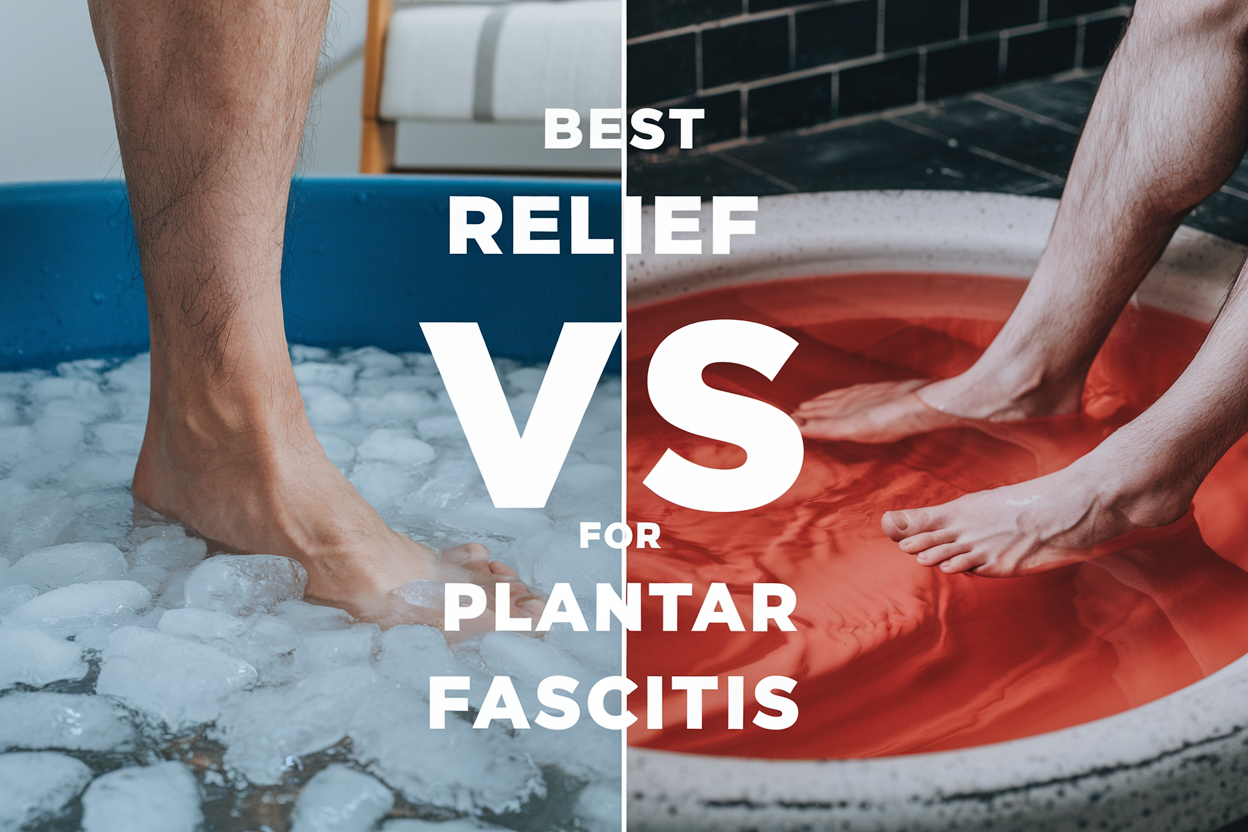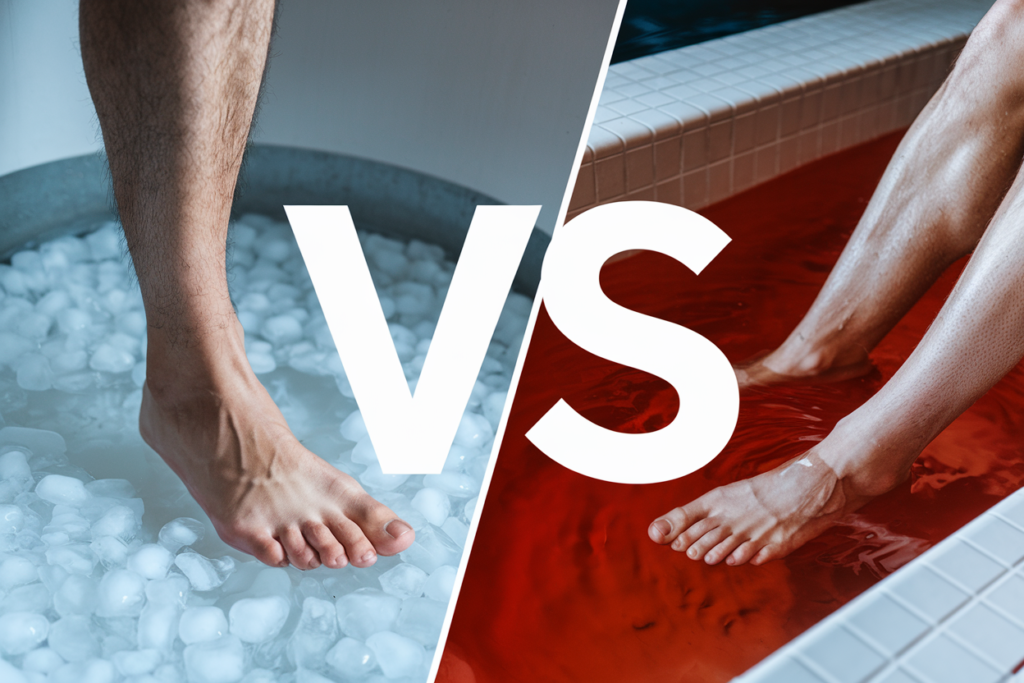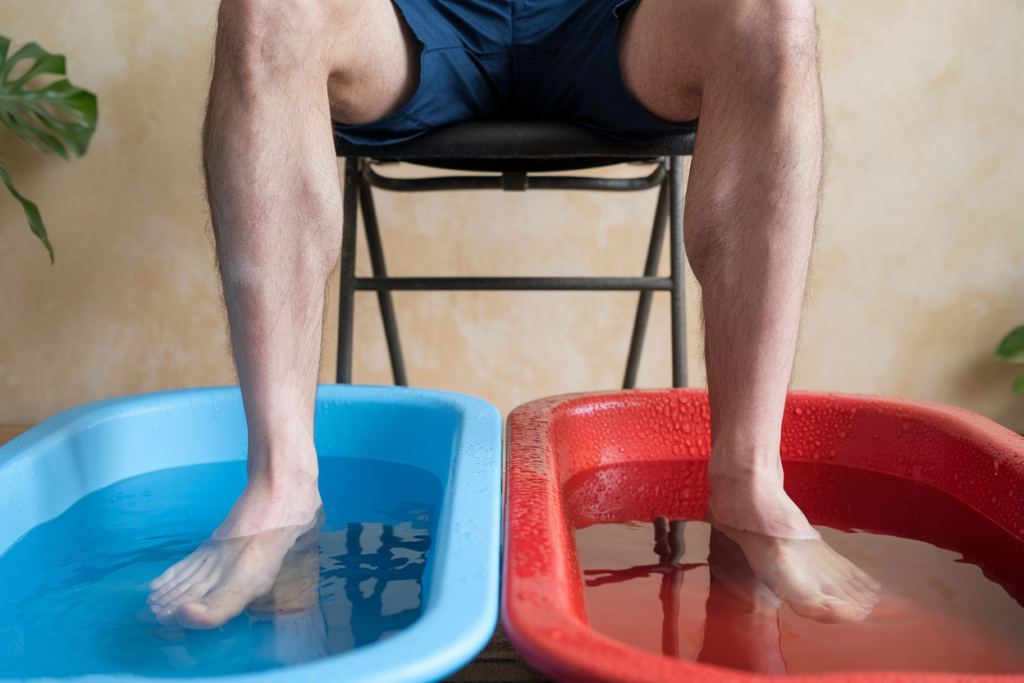Best Relief for Plantar Fasciitis: Ice or Heat?

Imagine a runner, ready to hit the road for a weekend jog, but then feels a sharp pain in their heel. This is often the start of dealing with plantar fasciitis. It’s a common issue that happens when the plantar fascia, a tissue from heel to toes, gets inflamed. Many wonder if ice or heat is better for relief, which can be confusing.
Fortunately, using both ice and heat can help a lot. This approach can make recovery faster and ease the pain at home. We’ll look into these treatments and find out the best way to handle plantar fasciitis pain. By the end, you’ll know how to get back to your active self quickly.
Table of Contents
Understanding Plantar Fasciitis
Plantar fasciitis is when the plantar fascia, a thick tissue at the foot’s bottom, gets inflamed. This tissue connects the heel to the toes. People often feel a lot of heel pain, especially in the morning or after sitting for a long time. It’s a common issue, mainly affecting those between 40 and 70 years old.
Being overweight, running long distances, or having a job that makes you stand a lot can cause it. Flat feet or high arches can make it worse. Studies show it affects women a bit more than men, especially if they are active.
Most cases of plantar fasciitis get better in 3–12 months with the right care. Treatment includes rest, using ice to reduce swelling, and exercises to strengthen the foot. If it doesn’t get better, surgery might be an option, but it has risks that you should talk about with a doctor.
Knowing about this condition helps with managing and recovering from it. Spotting the signs early lets people get the right treatment and make changes to reduce pain and improve movement.
Symptoms of Plantar Fasciitis
People with plantar fasciitis often feel sharp heel pain at the heel’s bottom. This pain is usually worse in the morning or after sitting a lot. As you start moving, the pain might get better, but it can come back later, especially after being active.
It’s important to know these symptoms early. If ignored, foot discomfort can turn into chronic pain. Catching these signs early helps in starting the right treatment. Chiropractic care is a good option as experts can find and fix the root cause. For more info, check out this resource.
Knowing about plantar fasciitis symptoms is key to keeping your feet healthy and avoiding long-term problems. If you often feel heel pain, getting professional help is a good step towards feeling better and staying healthy.
What Causes Plantar Fasciitis?
Plantar fasciitis comes from different things that cause foot pain and swelling. A big reason is doing the same activities over and over, like running or standing a lot. These actions put a lot of pressure on the plantar fascia, causing small tears and swelling.
Risk factors are key in getting this condition. Being overweight puts more stress on your feet, making plantar fasciitis more likely. Also, people over 40 are more at risk because their ligaments and tendons wear out over time.
How your foot is shaped can also lead to plantar fasciitis. If you have flat feet or a high arch, your feet may not spread the weight evenly while walking, causing pain. Wearing shoes that don’t support your feet, especially if you stand a lot at work, can make things worse.
Knowing what causes plantar fasciitis helps us spot the patterns that lead to it. By understanding risk factors and making smart choices about shoes, exercise, and weight, we can prevent and manage this common problem better.
Importance of Early Treatment
Getting treatment early for plantar fasciitis is key to managing pain and getting better. Waiting too long can make symptoms last longer and increase the chance of chronic pain. A well-planned approach can greatly improve recovery.
Using the RICE method—rest, ice, compression, and elevation—is crucial for quick relief. It’s very important for sudden injuries.
Adding gentle stretching exercises to your daily routine helps with healing and makes muscles stronger. Studies show that 83 percent of people who stretched regularly saw their plantar fasciitis symptoms improve. Wearing custom orthotics suggested by podiatrists also helps reduce pain during everyday activities.
Using nonsteroidal anti-inflammatory drugs (NSAIDs) like ibuprofen or aspirin can help reduce inflammation. Epsom salt baths can also help with pain and relaxation.
Being proactive early on helps you stay active and lowers the risk of making things worse. Getting treatment early can prevent the need for more serious treatments like cortisone injections or surgery. This leads to a better outcome.
First Steps for Plantar Fasciitis Pain Relief

Managing plantar fasciitis pain starts with taking proactive steps. Resting your foot and avoiding activities that make the pain worse is key. Using ice therapy can help by reducing inflammation and easing pain. This method not only helps with pain but also aids in healing.
Wearing supportive shoes is crucial for relief from plantar fasciitis pain. Choose lace-up athletic shoes over high heels or narrow-toed ones. Adding insoles, heel cups, and arch supports can make a big difference in comfort and support.
Using self-care strategies like night splints can help with recovery. They stretch the plantar fascia and calf muscles while you sleep. This keeps pain at bay over time. Also, compression socks designed for plantar fasciitis can improve blood flow and reduce swelling and pain.
Combining ice and heat therapy can boost circulation and ease cramps. Over-the-counter anti-inflammatory drugs, such as ibuprofen, can also help by reducing pain and swelling.
| Self-Care Strategies | Description |
|---|---|
| Rest | Avoid activities that worsen the pain. |
| Ice Therapy | Apply ice packs to reduce inflammation. |
| Supportive Footwear | Use shoes with good arch support and cushioning. |
| Night Splints | Gently stretch the plantar fascia and calf muscles during sleep. |
| Compression Socks | Improve blood flow and reduce pain in the heel and arch. |
Starting early can lead to effective long-term recovery from plantar fasciitis. For a full treatment plan, talk to a healthcare professional. They can guide you on the best home treatments. These steps will help reduce discomfort and support healing.
Ice Therapy for Plantar Fasciitis
Ice therapy is a great way to lessen inflammation and ease pain from plantar fasciitis. It makes blood vessels smaller and reduces swelling. This brings relief to those with plantar fasciitis. Using cold therapy often can also help heal faster and improve movement.
How Ice Helps Reduce Inflammation
Cold therapy cuts down on inflammation by making blood vessels smaller. This means less blood flows to the affected area. This helps decrease pain and swelling from plantar fasciitis. Using it regularly can make recovery faster and help your foot work better.
Methods to Apply Ice Therapy
There are many ways to use ice therapy. Here are some popular methods:
- Ice Therapy Slippers
- Ice Packs
- Frozen Vegetables (like peas)
- Paper Cups filled with ice
- Water Bottles filled with ice
Ice packs are good for targeting specific spots. An ice bath works well for covering a larger area. But, be careful not to freeze your skin. If you feel pins and needles or lose feeling, take off the ice right away.
Recommended Frequency and Duration for Icing
Ice your plantar fasciitis for 10 to 20 minutes at a time. Do this twice a day, especially after doing things that hurt. Don’t ice your heel right after waking up, as it might make it hurt more. Icing too much can harm your tissues, so stick to the recommended times.
| Aspect | Recommendation |
|---|---|
| Icing Duration | 10-20 minutes |
| Icing Frequency | Twice a day |
| Safety Note | Remove ice if sensation is lost or if ‘pins and needles’ are felt |
| Application Avoidance | Do not ice first thing in the morning |
Follow these tips for effective ice therapy for plantar fasciitis. It will help with healing and lessen pain.
Heat Treatment for Plantar Fasciitis

Heat treatment is key for easing plantar fasciitis symptoms and speeding up healing. Heat boosts blood flow, easing muscle tightness and reducing stiffness. Many people find relief with hot packs, heating pads, or warm baths.
Benefits of Heat Therapy
Heat therapy has many benefits for plantar fasciitis sufferers:
- Increases blood flow to the affected area
- Helps to reduce stiffness and relax tight muscles
- Soothes cramping and discomfort
- Can prepare soft tissues for stretching and physical activities
How to Effectively Apply Heat
Using heat the right way can greatly improve comfort:
- Use heating pads or hot packs on the affected area for at least 20 minutes.
- Warm baths are another great way to relax the muscles.
- Make sure the temperature is not too hot to avoid burns.
When Heat Might Be Counterproductive
Heat therapy has many benefits, but it’s important to know the risks. Using heat with swelling can make things worse, especially in the early stages.
If you have ongoing swelling, heat might not be the best choice. Consider contrast therapy, which alternates between heat and cold. Starting and ending with cold can reduce swelling, while heat helps with stiffness during recovery.
| Heat Therapy | Ice Therapy |
|---|---|
| Best for chronic pain and stiffness | Best for acute inflammation |
| Enhances blood flow | Reduces swelling and inflammation |
| Can be applied with heating pads or warm baths | Applied with ice packs on and off for 15 to 20 minutes |
| May worsen swelling if used inappropriately | Effective in alleviating acute discomfort |
Ice or Heat for Plantar Fasciitis: Which Is Best?
Choosing between ice or heat for plantar fasciitis can be tough. Knowing the benefits of each helps make a good choice. Both ice and heat have unique healing properties for plantar fasciitis.
Comparing the Benefits of Ice vs. Heat
In the plantar fasciitis comparison, ice is best in the early stages. Cold therapy, like ice packs, cuts down on swelling and helps relieve pain. Users find relief by using ice for 15 to 20 minutes, with a cloth between the ice and skin.
Heat therapy is good for chronic pain and stiffness. It makes blood vessels bigger and helps blood flow better to the area. Many find relief by soaking their feet in warm water for at least 20 minutes, but avoid this during the early stages of inflammation.
User Experiences and Testimonials
People have different experiences with ice versus heat for therapy effectiveness. Many switch between the two and find ice reduces inflammation and heat helps with relaxation and flexibility.
Testimonials often talk about the benefits of using both ice and heat. Some like using contrast baths with hot and cold water to manage symptoms. Others say combining ice therapy with rest, NSAIDs, and orthotics helps them recover faster.
| Method | Best For | Recommended Duration | Key Benefits |
|---|---|---|---|
| Ice Therapy | Acute pain and inflammation | 15-20 minutes | Reduces swelling, provides temporary pain relief |
| Heat Therapy | Chronic pain and stiffness | 20 minutes minimum | Improves flexibility, enhances blood circulation |
With more people getting plantar fasciitis, especially after spending more time at home, finding the right treatment is key. Knowing about these methods helps people choose the best treatment for their needs.
Contrast Therapy: Combining Ice and Heat
Contrast therapy is a strong healing strategy that uses both cold and hot treatments. It boosts blood flow and helps heal issues like plantar fasciitis. By doing contrast therapy, people can lessen pain and swelling with alternating treatments.
What is Contrast Therapy?
This therapy switches cold and hot treatments to help with recovery. Cold makes blood vessels smaller, cutting blood flow to the area. Then, hot makes them bigger, bringing more blood and nutrients. This mix of temperatures uses both extremes well.
How to Perform Contrast Therapy for Healing
To do contrast therapy right, follow these steps:
- Gather two containers: one with ice water (45 – 70 °F) and one with warm water (98 – 110 °F).
- Soak the affected foot in ice water for 1 minute to shrink swelling.
- Switch to warm water for 3 to 4 minutes to boost blood flow.
- Do this cycle 3 to 4 times for a 20-minute effective healing session.
This alternating therapies approach can help with plantar fasciitis pain. Be careful not to use heat on swollen or hot joints. Wait at least 48 hours after an injury before starting. Always check with a doctor if you have any concerns.
Over-the-Counter Pain Relief Options
Many people with plantar fasciitis use over-the-counter medications for pain relief. These options are easy to get and help with the pain and swelling from this condition. Knowing about the common choices and how they work can help you find the best relief.
Common Medication Choices
Popular over-the-counter medications include:
- Ibuprofen (Advil)
- Naproxen (Aleve)
- Acetaminophen (Tylenol)
These medicines help with pain and swelling, which is key for those with plantar fasciitis. Always follow the instructions on the package and talk to a healthcare provider if your symptoms don’t get better or get worse.
Role of Non-steroidal Anti-inflammatory Drugs (NSAIDs)
NSAIDs are crucial for managing pain in people with plantar fasciitis. They reduce swelling, make moving easier, and help with recovery. They work by lowering inflammation to reduce pain.
| Medication | Active Ingredient | Typical Use |
|---|---|---|
| Advil | Ibuprofen | Pain relief and reducing inflammation |
| Aleve | Naproxen | Long-lasting pain relief |
| Tylenol | Acetaminophen | Pain relief, not anti-inflammatory |
Using these over-the-counter medications correctly can really help with healing plantar fasciitis. Following the dosage instructions and knowing how NSAIDs work can lead to better pain relief.
Footwear Recommendations for Plantar Fasciitis
Choosing the right shoes is key to preventing and managing plantar fasciitis. Shoes with good support help ease pain and keep your foot’s structure right. Look for plantar fasciitis shoes with enough arch support, cushioning, and stability. These shoes can greatly improve your daily comfort.
Here are some key features to consider when selecting footwear:
- Arch Support: Proper arch support spreads your weight evenly and lessens strain on the plantar fascia.
- Cushioning: Good cushioning absorbs shock and makes your feet more comfortable, especially if you’re on your feet a lot.
- Heel Height: Stay away from high heels as they can make heel pain worse by putting too much pressure on the forefoot.
- Stability: Shoes with good stability stop your foot from moving too much, lowering the risk of injury.
Avoid flip-flops and other shoes that don’t support your feet well, as they can lead to plantar fasciitis. Using orthotic inserts in your shoes can give you more arch support. Physical therapy can also suggest specific plantar fasciitis shoes for your needs.
Choosing the right shoes helps with recovery and can prevent future problems. Since about 75% of people with plantar fasciitis might get better without a lot of treatment, the right shoes could be crucial for your recovery. For more on how mental health affects conditions like plantar fasciitis, check out this informative resource.
Incorporating Stretching Exercises into Your Routine
Adding stretching exercises to your daily routine is key for managing and preventing plantar fasciitis. These exercises focus on the calf muscles and the plantar fascia. They are vital for foot health. Regular heel pain stretching can bring great relief, reduce tension, and boost mobility.
Effective Stretches for Plantar Fasciitis Relief
Targeted stretching exercises are a great help for those with plantar fasciitis. Important stretches to try include:
- Towel Stretch: Use a towel to pull your toes towards you while keeping your knee straight. This targets the calf and Achilles tendon.
- Wall Stretch: Stand with one foot behind you and straight. Lean forward to stretch your calf.
- Frozen Bottle Roll: Roll your foot over a frozen water bottle for stretching and cold therapy to reduce inflammation.
How Stretching Can Benefit Recovery
Regular stretching helps increase flexibility and prevents stiffness. It offers more than just immediate relief. It also boosts blood circulation and reduces tightness in the affected areas. Stretching exercises can help in plantar fasciitis recovery by loosening the fascia and muscles. Aim to stretch for at least 30 seconds for best results.
In conclusion, making stretching a part of your routine is crucial for foot health. With dedication over a few weeks, you’ll see improvements in pain levels and foot function.
| Stretching Exercise | Duration | Benefits |
|---|---|---|
| Towel Stretch | 30 seconds | Targets calf muscles and Achilles tendon |
| Wall Stretch | 30 seconds | Stretches calf muscles effectively |
| Frozen Bottle Roll | 10 minutes (after activity) | Combines stretching with cold therapy |
Natural Home Remedies for Plantar Fasciitis
Many people look for natural remedies to ease plantar fasciitis pain. These home treatments can work well with traditional methods. They offer relief and boost overall health.
Lavender essential oil is a top choice because it fights inflammation. A study in 2015 found it could lessen pain from inflammation. Putting a little diluted lavender oil on the sore spot can help calm it down.
Aloe vera is great for its anti-inflammatory and antibacterial qualities. You can use it on your skin or take it inside to help with plantar fasciitis. Soaking your feet in warm water with apple cider vinegar can also be beneficial.
Herbs like turmeric, ginger, and chamomile are often used at home for swelling and pain. Adding these to your meals or using them on your skin might ease your pain.
- Using mustard oil for foot massages can relax you and improve blood flow.
- Applying cabbage leaves on the affected area might lessen pain and swelling.
- Strengthening your foot muscles with marbles can help with balance and walking.
Night splints can be a big help for ongoing pain. They’re especially useful after six months of plantar fasciitis. These devices stretch the plantar fascia while you sleep, which can ease pain.
Managing your weight is also key. Losing weight can ease pressure on the plantar fascia, making it easier to move. It’s smart to talk to a health expert for a diet and exercise plan that works for you.
When to Seek Professional Help
Knowing when to get medical help is key to handling plantar fasciitis well. If symptoms don’t get better or get worse at home, it’s time for a deeper check-up. Severe pain that makes daily tasks hard can really lower your quality of life. So, seeing a healthcare expert is a must.
Signs That Indicate You Should See a Doctor
Think about getting professional help if you notice these signs:
- Pain that lasts more than a few weeks without getting better
- Severe discomfort that makes walking or standing hard
- Swelling or tenderness in the heel or arch
- Symptoms that get worse after you’re active, showing it’s getting worse
- Pain that comes back when you get up in the morning
These signs often mean you need a check-up and possibly more medical help for plantar fasciitis.
Potential Medical Interventions for Severe Cases
If you’re dealing with a lot of pain or problems, you might need these treatments:
- Corticosteroid Injections: To quickly reduce inflammation and pain.
- Physical Therapy: Special exercises to help with strength and flexibility.
- Surgery: Only for extreme cases where other treatments don’t work.
Talking with a healthcare provider in detail helps figure out the best treatment plan. This shows how important it is to get personalized help for plantar fasciitis.
Long-term Management Strategies
Managing plantar fasciitis over time is key to avoiding future pain and keeping your feet healthy. Regular stretching exercises can make your plantar fascia and muscles more flexible. This helps ease heel pain and makes moving around easier.
Keeping a healthy weight also helps by reducing pressure on your plantar fascia. This lowers the chance of pain coming back.
Choosing the right shoes is vital for preventing plantar fasciitis. Shoes with good arch support and cushioning can help a lot. Using shoe inserts or orthotics can also ease pressure on your arches.
If you think about physical therapy, find a therapist who can give you exercises to strengthen your calf muscles and improve foot stability.
Remember, taking care of yourself is important too. Using ice or heat for pain can help control inflammation. By using these strategies, you can lessen discomfort and improve your foot health over time.
FAQ
What is the best method to relieve plantar fasciitis pain, ice or heat?
How often should I apply ice therapy for plantar fasciitis?
Can heat treatment worsen my plantar fasciitis symptoms?
Are there any effective home remedies for plantar fasciitis?
When should I consider seeing a doctor for my plantar fasciitis?
Are there specific types of footwear recommended for plantar fasciitis?
What are some stretching exercises that can help with plantar fasciitis?
Can over-the-counter medications help with plantar fasciitis?
What is contrast therapy, and how can it help plantar fasciitis?
How can maintaining a healthy weight help manage plantar fasciitis?






